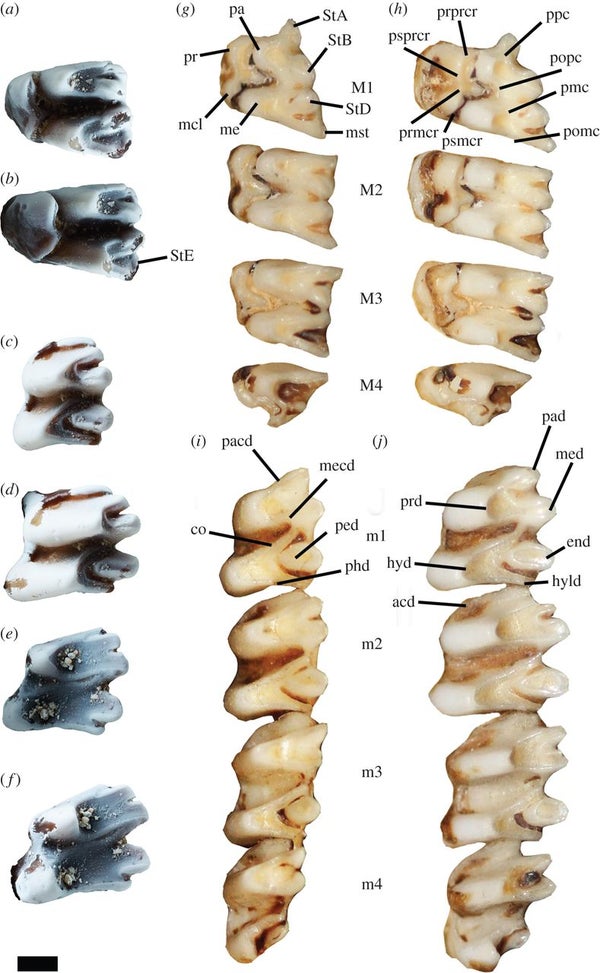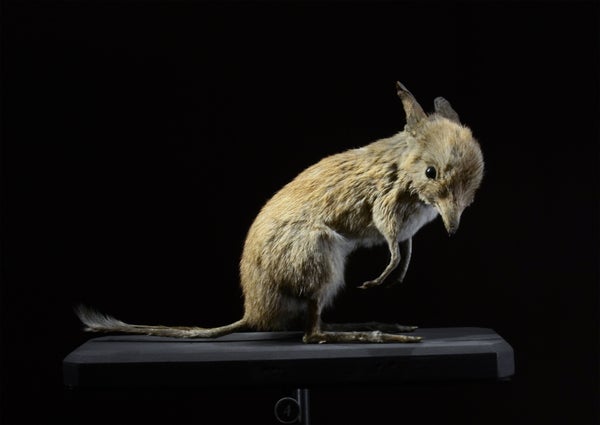This article was published in Scientific American’s former blog network and reflects the views of the author, not necessarily those of Scientific American
There are some animals that make me think "Seriously? How could this be a thing?" The pig-footed bandicoot is one of them. I only just learned of the little mammal's existence, and, unfortunately, I'm too late to see one alive. The last of these marsupials were wiped out by the 1950s, the very end of a lineage stretching back to the Pliocene.
The pig-footed bandicoot got its name from its unusual tootsies. This little beast, which looked like a snouty version of a kangaroo rat, had only two two toes on its forefeet and only one functional toe on its hindfeet, the rest reduced to vestigial splints. Now, paleontologist Kenny Travouillon reports, a trio of teeth extends the range of these unusual mammals two million years earlier than previously thought.
The teeth were extricated from Fisherman's Cliff in New South Wales Australia. They resemble those of the recently-extinct pig-footed bandicoot, Travouillon reports, but the crowns are lower and are otherwise different enough to represent a new species - Chaeropus baynesi.
Lower tooth crowns hints that the more ancient pig-footed bandicoot would have worn down its teeth faster than its more recent relative, Travouillon writes, and the older species also lacked a shearing specialization that the modern iteration used to slice through grasses. While the modern pig-footed bandicoot was a grazer, the older species probably picked from a more cosmopolitan menu that could have included insects as well as vegetation. So sometime in the two million years between the two species, these mammals switched from munching on varied foods to becoming grazers - a strange switch for a mammal, since small body size is thought to require food that provides more nutrition than grass. We may never know why. The pig-footed bandicoot was able to survive over two million years of climate and environmental change, but it could not withstand our species.
On supporting science journalism
If you're enjoying this article, consider supporting our award-winning journalism by subscribing. By purchasing a subscription you are helping to ensure the future of impactful stories about the discoveries and ideas shaping our world today.

The teeth of Chaeropus baynesi (left) compared with those of its more recent relative. Credit: Travouillon 2016
Fossil Facts
Name: Chaeropus baynesi
Meaning: Chaeropus is the genus of the recently-extinct pig-footed bandicoot, and baynesi is a fossil species named in honor of mammalogist Alexander Baynes.
Age: Pliocene-Pleistocene, 2.92-2.47 million years old.
Where in the world?: New South Wales, Australia.
What sort of critter?: A bandicoot related to the recently extinct Chaeropus ecaudatus.
Size: Unknown, but estimated at less than half a pound.
How much of the creature’s body is known?: Three molars.
Reference:
Travouillon, K. 2016. Oldest fossil remains of the enigmatic pig-footed bandicoot show rapid herbivorous evolution. Royal Society Open Science. doi: 10.1098/rsos.160089
Previous Paleo Profiles:
The Light-Footed Lizard The Maoming Cat Knight’s Egyptian Bat The La Luna Snake The Rio do Rasto Tooth Bob Weir's Otter Egypt's Canine Beast The Vastan Mine Tapir Pangu's Wing The Dawn Megamouth The Genga Lizard The Micro Lion The Mystery Titanosaur The Echo Hunter The Lo Hueco Titan The Three-Branched Cicada The Monster of Minden
